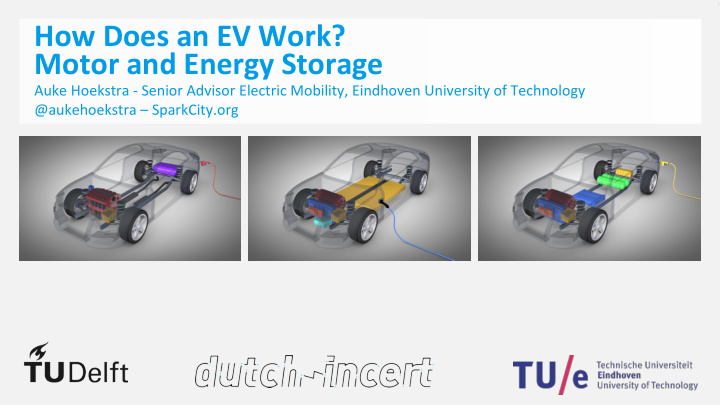



How Does an EV Work? Motor and Energy Storage Auke Hoekstra - Senior Advisor Electric Mobility, Eindhoven University of Technology @aukehoekstra – SparkCity.org
Two fundamental characteristics of every car Energy storage Motor
Two fundamental characteristics of every car Energy storage
Two fundamental characteristics of every car Motor
Fundamentally only two types of car motors Heat engine Electric motor
Heat engine: how it works Here a four stroke engine: 1. Inject fuel 2. Compress fuel Image source: Own work – Zephyris, Wikipedia 3. Ignite fuel: – Free energy – Create motion 4. Emit exhaust
Heat engine: drawbacks Complex, heavy, big & expensive • Maintenance & wearing out • 75% of energy is wasted • (95% with a Bugatti Veyron) Doesn’t run on renewable energy • from solar or wind Unhealthy exhaust • Every liter of gasoline produces • 2.3 kg of CO2
Electric motor: how it works • Magnetic field reject and attract based on polarity Image source: Own work - Geek3, Wikipedia
Electric motor: how it works • Magnetic field reject and attract based on polarity • Electricity flowing through a coil creates a magnetic field Image source: DC Motor, Lookang, Wikipedia • A coil between magnetic fields starts to rotate
Electric motor: advantages Only one moving part (rotor) • Light, compact, simple, no • maintenance and inexpensive Lasts essentially forever • Efficiency close to 100% & braking • can charge battery: 4x better than average car • 20x better than sportscar • Much better acceleration • Can run on renewable energy • No exhaust gases •
Heat engine vs electric motor Internal combustion Electric motor Electric motor is... 1-3 kW/kg 3-10 kW/kg 3x more powerful 0.4 kW/L 13.6 kW/L 40x smaller 5-30 % efficient 93-96 % efficient 3-20x more efficient Many moving parts One moving part Maintenance free
Fuel versus batteries Fuel Batteries
The extra weight of batteries Energy Compared to Energy source Year gasoline (Whr/kg) Gasoline 1900-20?? 12 000 - Image source: appletips.nl
The extra weight of batteries Energy Compared to Energy source Year gasoline (Whr/kg) Gasoline 1900-20?? 12 000 - Lead-acid 1900 10 1200x worse
The extra weight of batteries Energy Compared to Energy source Year gasoline (Whr/kg) Gasoline 1900-20?? 12 000 - Lead-acid 1900 10 1200x worse Lead-acid 2000 35 350 worse
The extra weight of batteries Energy Compared to Energy source Year gasoline (Whr/kg) Gasoline 1900-20?? 12 000 - Lead-acid 1900 10 1200x worse Lead-acid 2000 35 350 worse NiMh 2000 80 150x worse
The extra weight of batteries Energy Compared to Energy source Year gasoline (Whr/kg) Energy Year Density Compared Source Wh/kg to Gasoline Gasoline 1900-20?? 12 000 - Image source: Nokia Li-ion battery – Kristoferb, Wikipedia Gasoline 1900-20?? 12 000 - Lead-acid 1900 10 1200x worse Lead-acid 1900 10 1200x worse Lead-acid 2000 35 350 worse Lead-acid 2000 35 350 worse NiMh 2000 80 150x worse NiMh 2000 80 150x worse Lithium 2015 250 50x worse Lithium 2015 250 50x worse
The extra weight of batteries Image source: Cylindrical cell (18650) prior to assembly – RudolfSimon, Wikipedia Energy Compared to Energy source Year gasoline (Whr/kg) Gasoline 1900-20?? 12 000 - Lead-acid 1900 10 1200x worse Lead-acid 2000 35 350 worse NiMh 2000 80 150x worse Lithium 2015 250 50x worse Lithium 2025 400 30x worse
The extra weight of batteries Energy Compared to Energy source Year gasoline (Whr/kg) Gasoline 1900-20?? 12 000 - ? Lead-acid 1900 10 1200x worse Lead-acid 2000 35 350 worse NiMh 2000 80 150x worse Lithium 2015 250 50x worse Lithium 2025 400 30x worse Lithium-air ???? 12 000* same *This is the theoretical maximum energy content of lithium air batteries.
The extra weight of batteries, simplified Image source: A femal African bush elephant - Muhammad Mahdi Karim, Wikipedia Energy Extra kg for Year Equals source 500 km Lead-acid 1900 10 000 Elephant
The extra weight of batteries, simplified Energy Extra kg for Year Equals source 500 km Image source: Diceros Bicornis – Jonathunder, Wikipedia Lead-acid 1900 10 000 Elephant Lead-acid 2000 3 000 Rhinoceros
The extra weight of batteries, simplified Energy Extra kg for Year Equals source 500 km Lead-acid 1900 10 000 Elephant Lead-acid 2000 3 000 Rhinoceros NiMh 2000 800 Bison
The extra weight of batteries, simplified Energy Extra kg for Year Equals source 500 km Image source: Male silverback – Brocken Inaglory, Wikipedia Lead-acid 1900 10 000 Elephant Lead-acid 2000 3 000 Rhinoceros NiMh 2000 800 Bison Lithium 2015 400 Gorilla
The extra weight of batteries, simplified Energy Extra kg for Year Equals source 500 km Lead-acid 1900 10 000 Elephant Lead-acid 2000 3 000 Rhinoceros NiMh 2000 800 Bison Lithium 2015 400 Gorilla Lithium 2025 200 Pig* *Taking the weight of the drivetrain into account, the electric car is ~200 kg lighter.
The rapidly falling cost of batteries Source: “Rapidly falling costs of battery packs for electric vehicles” by Björn Nykvist and Mans Nilsson, Nature Climate Change, March 2015 Added blue line is original research. Image source: appletips.nl
Conlusions • Only two motors for cars and internal combustion is no match for electric • Batteries were prohibitively heavy (elephant) but not anymore (pig) and EV now lighter • Plummeting battery prices make EV the cheaper option
Thank you for your attention
Recommend
More recommend